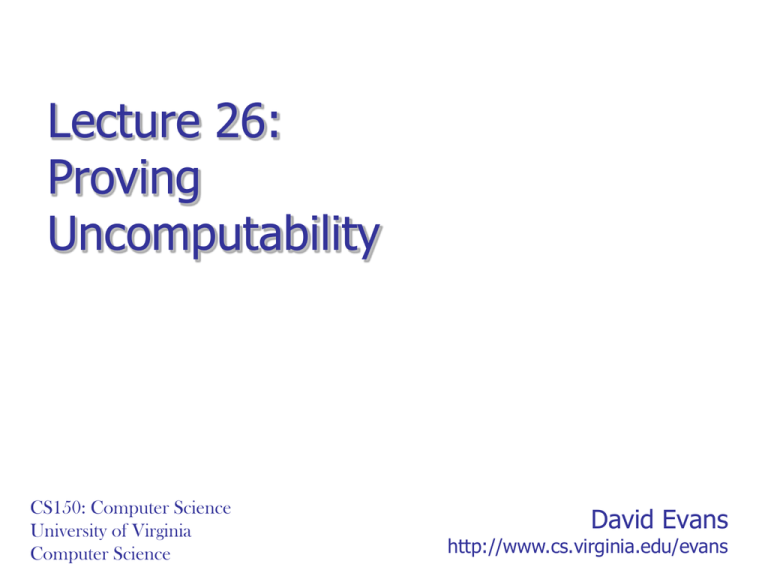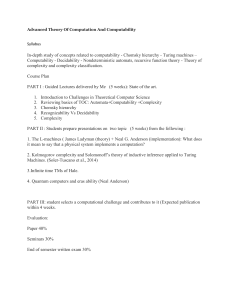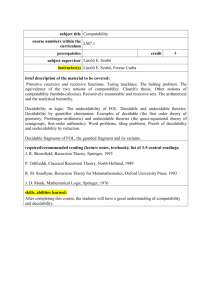Lecture 26: Proving Uncomputability David Evans
advertisement

Lecture 26: Proving Uncomputability CS150: Computer Science University of Virginia Computer Science David Evans http://www.cs.virginia.edu/evans From Paul Graham’s “Undergraduation”: My friend Robert learned a lot by writing network software when he was an undergrad. One of his projects was to connect Harvard to the Arpanet; it had been one of the original nodes, but by 1984 the connection had died. Not only was this work not for a class, but because he spent all his time on it and neglected his studies, he was kicked out of school for a year. ... When Robert got kicked out of grad school for writing the Internet worm of 1988, I envied him enormously for finding a way out without the stigma of failure. ... It all evened out in the end, and now he’s a professor at MIT. But you’ll probably be happier if you don’t go to that extreme; it caused him a lot of worry at the time. 3 years of probation, 400 hours of community service, $10,000+ fine Lecture 26: Proving Computability 2 Morris Internet Worm (1988) • P = fingerd – Program used to query user status – Worm also attacked other programs • I = “nop400 pushl $68732f pushl $6e69622f movl sp,r10 pushl $0 pushl $0 pushl r10 pushl $3 movl sp,ap chmk $3b” (is-worm? ‘(P I)) should evaluate to #t • Worm infected several thousand computers (~10% of Internet in 1988) Lecture 26: Proving Computability 3 Worm Detection Problem Input: A program P and input I Output: true if evaluating (P I) would cause a remote computer to be “infected”. Virus Detection Problem Input: A program specification P Output: true if evaluating (P) would cause a file on the host computer to be “infected”. Lecture 26: Proving Computability 4 Uncomputability Proof Suppose we could define is-virus? Then: (define (halts? P) (is-virus? ‘(lambda () (begin ((remove-infects P)) (infect-files))))) Lecture 26: Proving Computability 5 Uncomputability Proof (define (halts? P) (is-virus? ‘(lambda () (begin ((remove-infects P)) (infect-files))))) #t: Since it is a virus, we know (infect-files) was evaluated, and P must halt. #f: The (infect-files) would not evaluate, so P must not halt. Lecture 26: Proving Computability 6 Can we make removeinfects? Yes, just remove all file writes. “Solving” Undecidable Problems • No perfect solution exists: – Undecidable means there is no procedure that: • Always gives the correct answer • Always terminates • Must give up one of these to “solve” undecidable problems – Giving up #2 is not acceptable in most cases – Must give up #1 • Or change the problem: e.g., detect file infections during an execution Lecture 26: Proving Computability 7 Conclusion? • Anti-Virus programs cannot exist! “The Art of Computer Virus Research and Defense” Peter Szor, Symantec Lecture 26: Proving Computability 8 Actual is-virus? Programs • Give the wrong answer sometimes – “False positive”: say P is a virus when it isn’t – “False negative”: say P is safe when it is • Database of known viruses: if P matches one of these, it is a virus • Clever virus authors can make viruses that change each time they propagate – A/V software ~ finite-proof-finding – Emulate program for a limited number of steps; if it doesn’t do anything bad, assume it is safe Lecture 26: Proving Computability 9 Proof Recap • • • • If we had is-virus? we could define halts? We know halts? is undecidable Hence, we can’t have is-virus? Thus, we know is-virus? is undecidable Lecture 26: Proving Computability 10 How convincing is our Halting Problem proof? (define (contradict-halts x) (if (halts? contradict-halts null) (loop-forever) #t)) If contradict-halts halts, the if test is true and it evaluates to (loop-forever) - it doesn’t halt! If contradict-halts doesn’t halt, the if test if false, and it evaluates to #t. It halts! This “proof” assumes Scheme exists and is consistent! Lecture 26: Proving Computability 11 History of Object-Oriented Programming Lecture 26: Proving Computability 12 Pre-History: MIT’s Project Whirlwind (1947-1960s) Jay Forrester Lecture 26: Proving Computability 13 from Class 2... Why Whirlwind? 60000 Tsar Bomba (largest ever) 50000 Soviet Union test atomic bomb (Aug 29, 1949) 40000 30000 20000 B83 (1.2Mt), largest in currently active arsenal First H-Bomb (10Mt) 10000 0 1940 1950 1960 1970 1980 Hiroshima (12kt), Nagasaki (20kt) Lecture 26: Proving Computability 14 1990 2000 2010 2020 Whirlwind Innovations Magnetic Core Memory (first version used vacuum tubes) Lecture 26: Proving Computability 15 Sketchpad • Ivan Sutherland, 1963 (PhD thesis supervised by Claude Shannon) • Interactive drawing program • Light pen http://www.cl.cam.ac.uk/TechReports/UCAM-CL-TR-574.pdf Lecture 26: Proving Computability 16 Components in Sketchpad Lecture 26: Proving Computability 17 Objects in Sketchpad In the process of making the Sketchpad system operate, a few very general functions were developed which make no reference at all to the specific types of entities on which they operate. These general functions give the Sketchpad system the ability to operate on a wide range of problems. The motivation for making the functions as general as possible came from the desire to get as much result as possible from the programming effort involved. For example, the general function for expanding instances makes it possible for Sketchpad to handle any fixed geometry subpicture. The rewards that come from implementing general functions are so great that the author has become reluctant to write any programs for specific jobs. Each of the general functions implemented in the Sketchpad system abstracts, in some sense, some common property of pictures independent of the specific subject matter of the pictures themselves. Ivan Sutherland, Sketchpad: a Man-Machine Graphical Communication System, 1963 (major influence on Alan Kay developoing OOP in 1970s) Lecture 26: Proving Computability 18 Simula • Considered the first “object-oriented” programming language • Language designed for simulation by Kristen Nygaard and Ole-Johan Dahl (Norway, 1962) • Had special syntax for defining classes that packages state and procedures together Lecture 26: Proving Computability 19 Counter in Simula class counter; integer count; begin procedure reset(); count := 0; end; procedure next(); count := count + 1; end; integer procedure current(); current := count; end; end Lecture 26: Proving Computability 20 XEROX Palo Alto Research Center (PARC) 1970s: • Bitmapped display • Graphical User Interface – Steve Jobs paid $1M to visit and PARC, and returned to make Apple Lisa/Mac • • • • Ethernet First personal computer (Alto) PostScript Printers Object-Oriented Programming Lecture 26: Proving Computability 21 “Don’t worry about what anybody else is going to do… The best way to predict the future is to invent it. Really smart people with reasonable funding can do just about anything that doesn't violate too many of Newton's Laws!” — Alan Kay, 1971 Dynabook, 1972 (Just a model) Lecture 26: Proving Computability 22 • • • • Dynabook 1972 Tablet computer Intended as tool for learning Kay wanted children to program it also Hallway argument, Kay claims you could define “the most powerful language in the world in a page of code” • Proof: Smalltalk – Scheme is as powerful, but takes two pages – Before the end of the class, we will see an equally powerful language that fits in ¼ page Lecture 26: Proving Computability 23 BYTE Magazine, August 1981 Lecture 26: Proving Computability 24 Smalltalk • Everything is an object • Objects communicate by sending and receiving messages • Objects have their own state (which may contain other objects) • How do you do 3 + 4? send the object 3 the message “+ 4” Lecture 26: Proving Computability 25 Counter in Smalltalk class name counter instance variable names count new count <- 0 next count <- count + 1 current ^ count Lecture 26: Proving Computability 26 Counter Object in Scheme (define (make-counter) Instance variable (let ((count 0)) (lambda (message) (cond ((eq? message ’reset!) Methods (set! count 0)) ((eq? message ’next!) (set! count (+ 1 count))) ((eq? message ’current) count) (else (error "Unrecognized message")))))) Lecture 26: Proving Computability 27 Counter in Python class counter: def __init__(self): self._count = 0 def rest(self): self._count = 0 def next(self): self._count = self._count + 1 def current(self): return self._count Lecture 26: Proving Computability 28 Who was the first object-oriented programmer? Lecture 26: Proving Computability 29 By the word operation, we mean any process which alters the mutual relation of two or more things, be this relation of what kind it may. This is the most general definition, and would include all subjects in the universe. Again, it might act upon other things besides number, were objects found whose mutual fundamental relations could be expressed by those of the abstract science of operations, and which should be also susceptible of adaptations to the action of the operating notation and mechanism of the engine... Supposing, for instance, that the fundamental relations of pitched sounds in the science of harmony and of musical composition were susceptible of such expression and adaptations, the engine might compose elaborate and scientific pieces of music of any degree of complexity or extent. Ada, Countess of Lovelace, around 1830 Lecture 26: Proving Computability 30

